I hope that you will join me this Saturday, October 13, 2018 at Bolton Hall.
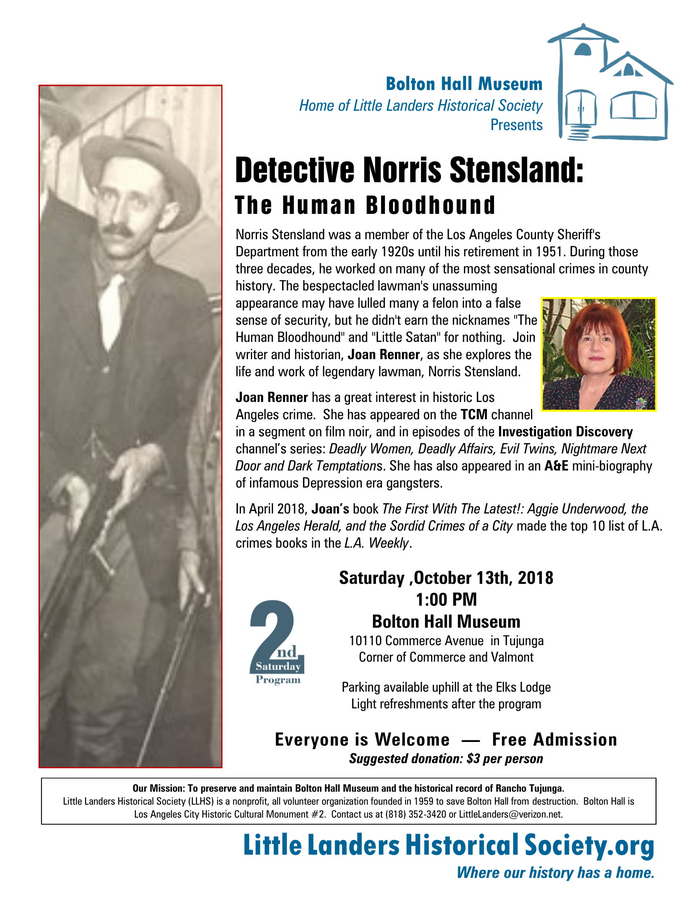

I hope that you will join me this Saturday, October 13, 2018 at Bolton Hall.

Not long after the bloody shootout between the Burton gang and Sheriff’s deputies at the Union Ice Company, in which all of the bandits except J.W. Gilkye were killed, deputies found Edward Burton’s girlfriend. Investigators located the young woman in a room at the Superior Hotel. She was taken into custody under her alias, Mary Dayke, but quickly revealed her given name, Evelyn Smith.
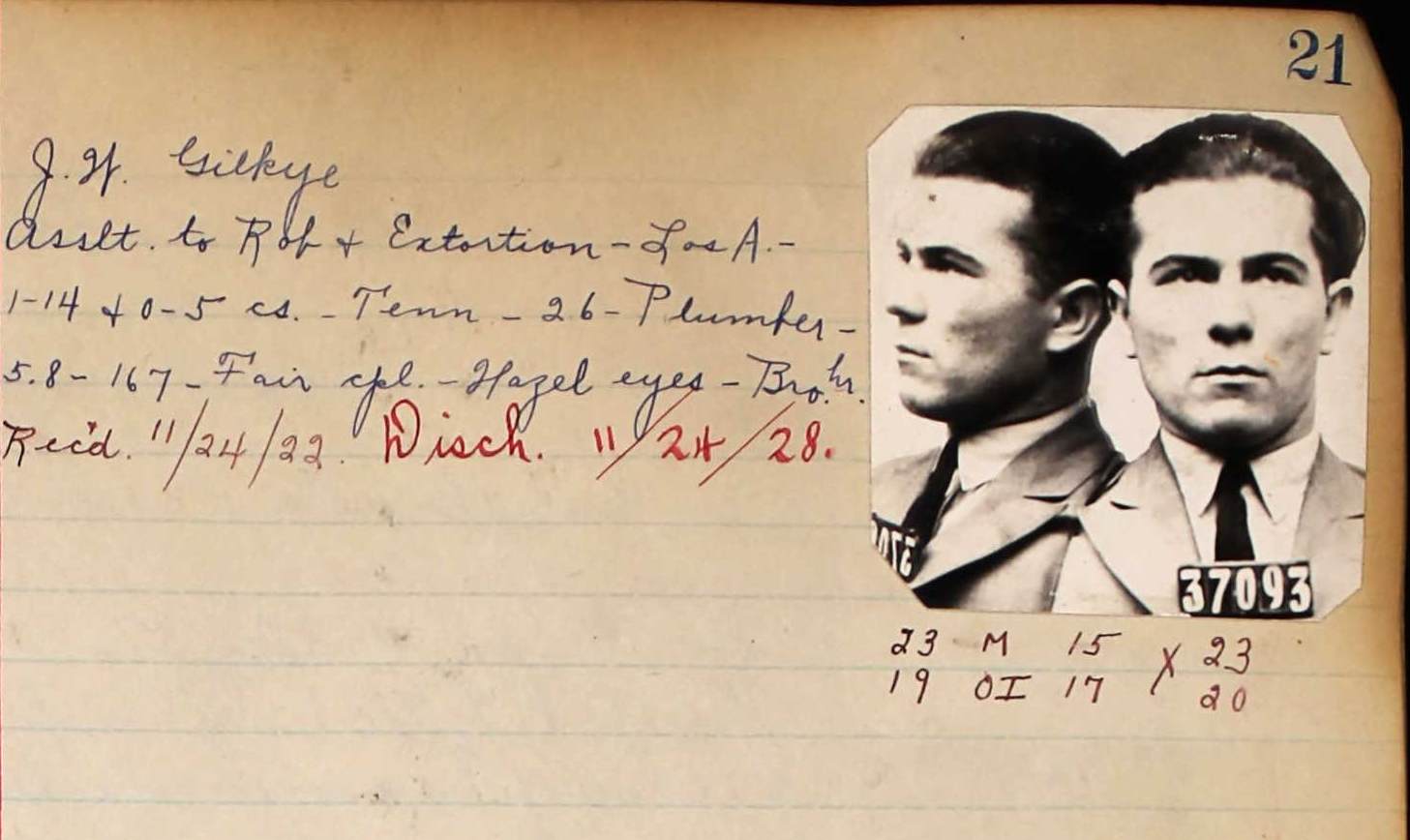
Smith, like Burton, was from Chicago. Questioned by Chief of Criminal Investigation, A.L. Manning and Deputy Sheriff Chester Allen, Smith said that she had no idea what Burton was up to or why he had left Chicago for Los Angeles. “I know nothing of Burton’s crimes. I did not realize he was leading a life of crime until he was arrested in the raid. Even then I did not believe he was the man who shot the motor officer.
Smith continued: “I came out from Chicago last May to join Burton. Be he soon lost interest in me. He told me I was not the kind of a girl to stick with him. Last Tuesday afternoon, only a few hours before he was killed, he accused me of being too inquisitive. He said I asked too many questions, told me to mind my own business. And then he beat me severely.”
Sheriff’s investigators asked Smith about the two one-way train tickets to Chicago that were found in Burton’s coat pocket, but again she claimed to know nothing. Evidently, Burton had a new woman in his life; a blonde with bobbed hair who had accompanied the bandit gang on a number of robberies. Smith said Burton planned to “ditch” her for his new squeeze and leave Smith in Los Angeles to fend for herself.
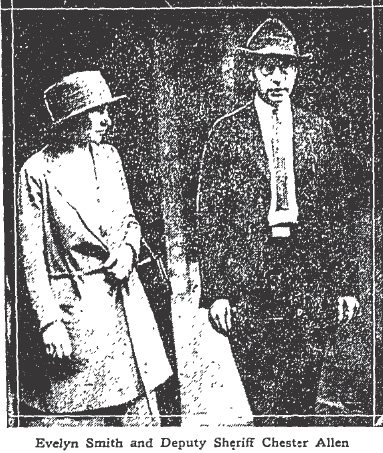
Sheriff’s deputies conducted raids at several locations in an attempt to round up other members of the gang. The lawmen came up empty. The gunsels, aware that the deputies wielded sawed-off shotguns and were prepared to do battle, had fled the city for parts east.
Only J.W. Gilkye, the lone bandit to survive, was left to answer for the crimes he and his fellow thugs had perpetrated. Gilkye survived only because he had dropped his weapon and refused to fight when deputies drew down on him at the ice company.
During questioning, Gilkye said: “You got enough on me without me telling you more.” And then he proceeded to tell Chief Deputy Manning a lot more. Like many crooks Gilkye loved the sound of his own voice and couldn’t resist crowing about his criminal accomplishments and playing the tough guy. “I may get hooked for a long time up the road, but I ain’t through yet. We were double-crossed, we were, by one of our own gang. But I’ll get him if it takes all my life. He double-crossed us and caused three of my best pals to get killed. But they were nervy–had the goods.” The “goods” can’t do much for you when you’re dead.
Gilkye wasn’t as nervy as his pals had been, so he lived to tell the tale. He was tried and convicted for his part in the ice company job, but before he left Los Angeles County Jail for San Quentin, he nearly made good on his promise to get even with the man who had dropped a dime on the gang.
The snitch was Roy Melendez. Melendez and Gilkye encountered each other in the County Jail where, according to witnesses, Gilkye “roared like an infuriated animal” when Melendez was placed in lock-up. Gilkye would have murdered Melendez with his bare hands if jail attendants hadn’t intervened.
Melendez may have met a bad end even though Gilkye wasn’t able to lay another finger on him. When Melendez failed to appear in court on a bum check charge an unnamed official opined: “Either Melendez has been killed or they have made it so hot for him he is afraid to show up.” A bench warrant was issued for Melendez, but he was nowhere to be found.
Members of the Sheriff’s Department breathed a sigh of relief. The Burton gang’s brief reign in Los Angeles was over.
* * *
Late in February 1923, two men from Chicago arrived in Los Angeles. The men weren’t tourists, they were on a mission to assassinate the deputies they held responsible for killing Edward Burton and two members of his gang during the shootout at Union Ice Company. The men made inquiries around town in an attempt to learn as much as they could about their targets. While the hitmen were compiling dossiers on their targets, the targets themselves were conducting their business as usual. Deputies William Bright, Spike Modie, Chester Allen and Norris Stensland didn’t know they were being hunted.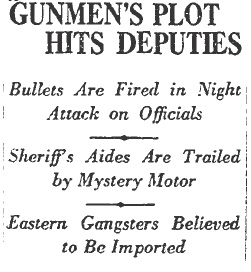
At about 1 a.m. on the morning of March 7, 1923, William Bright and Spike Moody left Sheriff’s headquarters. They climbed into Moody’s Stutz and headed up Broadway. They turned west on Temple and continued down the dark, deserted street. After traveling a few blocks they eyeballed a sedan with the side curtains pulled down. They wouldn’t have paid the automobile much attention except that it was trailing them too closely for their comfort. Knowing that they had enemies in the underworld Moody and Bright readied their weapons. As they prepared themselves for a possible gunfight, Moody and Bright watched the sedan suddenly swing off into a side street and disappear.
A few blocks later the mysterious sedan lurched out of a side street onto Temple and passed the Stutz at a high rate of speed. Moody and Bright saw the side curtains part and a shotgun appear. A second shotgun appeared from the tonneau, the rear passenger compartment of the sedan, and both unleashed a volley fire at Modie and Bright. The deputies pulled out their revolvers and returned fire. Bright fired through the windshield of the Stutz. Fortunately for the deputies, the would-be assassins aim went high when their sedan hit a pothole.

Stutz c. 1923
Moody jammed his foot down on the accelerator and gave chase as the sedan drew away. Bright continued to return fire. Bright may have scored a hit. The sedan skidded across the street into a telephone pole. The sedan sagged with one broken wheel. Three men jumped from the car and fled, but not before firing again at the deputies.
Bright and Moody gave chase on foot but the men vanished into the darkness. Returning to the crippled sedan Bright found a hat with a jagged hole through the crown. The wearer had narrowly escaped death. The hat bore the name of a Chicago hatter.
Sheriff’s investigators located the gunmen’s hotel room. They also identified a few of the shooters acquaintances who, under orders from Sheriff Traeger, were kept under surveillance.
Deputies Bright, Moody, Stensland and Allen prepared themselves for the possibility of another attack–but it never came. The Burton gang seems to have departed Los Angeles forever.

This is such a great photo I decided to post it again!
NOTE: Once again, I am indebted to Mike Fratantoni. His knowledge of L.A.’s law enforcement and criminal history is encyclopedic.
It can be frustrating to pin down accurate spellings of proper names in these historic tales. Often reporters phoned a story into a rewrite person at the newspaper who phonetically spelled a person’s name. Edward Burton was in some reports, Edwin. Another example, Spike Moody’s surname has appeared as Modie. Judging from the above photo it should be the former spelling.
For two weeks Sheriff’s deputies surveilled the four key members of the Burton gang: Edward Burton; J.W. Gilkye, Louis Reese, aka “Big Dick” or “Lefty Louie”; and Kenneth Fleenor. The surveillance paid dividends. Deputies learned that the gang was planning one last job before leaving for Chicago. They were going to rob the cashier at the Union Ice Company at 650 South Alameda Street.
The Burton gang had pulled a number of jobs in Los Angeles and local law enforcement had had enough. Sheriff Traeger put Chief of Criminal Investigation A. L. Manning in charge of catching the bandits in the act.
 At 6 p.m. on August 10, 1922, deputies, armed with sawed-off shotguns, surrounded the ice company building. They stayed in the shadows waiting for the Burton gang to show up. It was a long wait. At 9:30 p.m. a car parked on the west side of Alameda. Several men exited the vehicle and climbed between the cars of a slow moving freight train. They approached the factory office.
At 6 p.m. on August 10, 1922, deputies, armed with sawed-off shotguns, surrounded the ice company building. They stayed in the shadows waiting for the Burton gang to show up. It was a long wait. At 9:30 p.m. a car parked on the west side of Alameda. Several men exited the vehicle and climbed between the cars of a slow moving freight train. They approached the factory office.
Inside the office were E.R. Rathman, the night cashier and E.C. Bailey, one of the company’s drivers. Rathman was sitting at an adding machine and Bailey was asleep in a chair a few feet away. Also inside the office, in a side room, were more armed deputies.
One of the crooks stayed outside the building as a lookout. The other three men, all of them wearing white handkerchiefs over their faces, entered the office and pointed revolvers at Rathman. One of the gunmen said: “Stick up your hands.” Rathman did as he was told. With a pistol shoved up against the back of Rathman’s neck, he was commanded to “Get into that corner!” With his hands up, Rathman moved toward the corner. Another of the masked men looked at Rathman and said: “We don’t want to hurt you.” Was the gunman telling the truth? Rathman didn’t want to find out. When he was told to lie on his face on the floor he did so without complaint.
One of the armed men began to rifle the cash drawer and pulled out about $2,000 (approximately $30k in today’s dollars) in cash. It was then that four deputies, wielding sawed-off shotguns, rushed into the office and shouted for the bandits to put up their hands.
Burton, firing as he ran, made a beeline toward the exit He didn’t make it. One shot took out an eye and one side of his face was ripped away. He fell to the floor. He was alive–but just barely.
Louis Reese went out in a hail of gun fire. He ran toward the deputies who continued to fire. Hit multiple times, Louis reeled out of the door and onto the sidewalk where he collapsed and died.
Burton was transported to the County Hospital. Surgeons who examined the wounded bandit said that he was so grievously wounded that he could not live.
Detectives examined the contents of Burton’s pockets for information that might lead them to other gang members. Burton had two one-way tickets to Chicago where he planned to resume his place in the city’s criminal underworld. The cops were also interested in learning if Burton was in contact with any of his fellow gangsters. In particular, they hoped to find out if he knew anything about “Terrible” Tommy O’Connor.
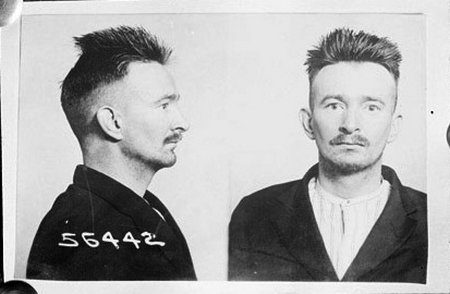
Terrible Tommy O’Connor
Rumor had it that Burton was tight with O’Connor, and O’Connor recently escaped from Chicago’s jail just days before he was scheduled to hang for the murder of a policeman. If Burton knew anything about O’Connor’s whereabouts the information accompanied him into the afterlife. Curiously, O’Connor was never recaptured and his date with the hangman remained on the books until the gallows were dismantled in the 1970s.
 J.C. Gilkye, the surviving member of the gang, gave Chief Investigator Manning an earful about the activities of the group. Gilkye said that not all of the gang’s attempted crimes were successful. Far from it. But even with the failures, they had done pretty well in Los Angeles — until their final job. Had the Burton gang been completely wiped out as law enforcement hoped? If they could locate Burton’s sweetheart maybe they’d know for sure.
J.C. Gilkye, the surviving member of the gang, gave Chief Investigator Manning an earful about the activities of the group. Gilkye said that not all of the gang’s attempted crimes were successful. Far from it. But even with the failures, they had done pretty well in Los Angeles — until their final job. Had the Burton gang been completely wiped out as law enforcement hoped? If they could locate Burton’s sweetheart maybe they’d know for sure.
NEXT TIME: The end of the Burton gang?